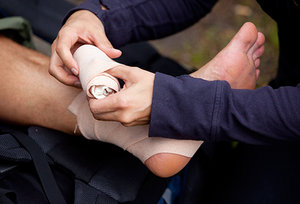In the U.S. alone, 23,000 people sprain their ankle each day, resulting in 1.6 million doctor office visits annually. The direct and indirect costs (e.g., lost days from work) associated with treating ankle sprains exceed $1.1 billion annually. To make matters worse, these numbers do not take into account the long-term disability often associated with ankle sprains. In a 10-year follow-up of patients suffering ankle sprains, 72 percent showed signs of arthritis in the ankle joint. Ankle problems can even be a source of dysfunction and pain in the lower back!
Given the serious long-term consequences associated with ankle sprains, it is important to identify which individuals are prone to injury. Although numerous factors have been proven to correlate with the development of ankle sprains (such as high arches, impaired balance, tight calves, and decreased cardiovascular fitness), by far, the best predictors of future ankle sprain are prior ankle sprain and being overweight. In fact, overweight athletes with a prior history of ankle sprain are 19 times more likely to suffer another ankle sprain. Because force centered on the ankle can exceed seven times body weight, even a few extra pounds will greatly increase your potential for ankle sprain.
Conversely, previous ankle sprain can result in impaired coordination and calf tightness that can increase your potential for reinjury. In a three-dimensional study of motion in the foot and ankle while walking, individuals with a prior history of ankle sprain had reduced ground clearance during swing phase in the foot was tilted in excessively when it hit the ground.
 Regardless of the degree of ligament damage, the goal of treating an
ankle sprain is to restore strength, flexibility, proprioception, and
endurance as quickly as possible during the first few days following
injury. The following is a popular treatment protocol for managing ankle
sprains that should be discussed with your doctor of chiropractic if
you suffer a sprain or are prone to sprains. Your doctor may utilize the
following to help you get back on your feet.
Regardless of the degree of ligament damage, the goal of treating an
ankle sprain is to restore strength, flexibility, proprioception, and
endurance as quickly as possible during the first few days following
injury. The following is a popular treatment protocol for managing ankle
sprains that should be discussed with your doctor of chiropractic if
you suffer a sprain or are prone to sprains. Your doctor may utilize the
following to help you get back on your feet.Phase 1: Unable to bear weight
- Compressive wrap with U-shaped felt balance around fibula. Change every four hours
- Active abduction / adduction of toes for five seconds; repeat 10 times
- Write out alphabet with toes, five times per day
- Stationary bike, 15 minutes per day
- Ankle rock board, seated (off-weight-bearing), 30 circles, performed clockwise and counterclockwise two times per day. Perform on uninjured ankle while standing for three minutes. This has been shown to increase proprioception in the contralateral limb
- Mild grade 3 and grade 4 mobilization of the joints of the foot and ankle
- Mobilize all stiff joints in the lower extremity and pelvis
- Band exercises in all planes; three sets of 25 in each direction
- Double-leg and then single-leg heel raises on the involved side, three sets of 10 reps, two times per day
- Standing closed-eye balance, 30 seconds, five times per day
- Standing single-leg ankle rock board, one minute, five time per day
- Closed kinetic-chain exercises
- Running at 80 percent full speed; avoid forefoot touch-down
- Mini-tramp; three sets of 30 jumps forward, backward and side to side. Begin on both legs; progress to single-limb
- Plyometrics on a 50 cm and 25 cm box, positioned 1 meter apart. Jump from one box to the ground, then to the other box, landing as softly as possible. Three sets of five reps.
Because foam pads and balance boards do not put your foot through a full range of motion, I recommend a rock board that forces your foot to tilt in more than it tilts out (which is how your ankle is designed to move). The board places your foot in the position of a future sprain and then forces you to use your muscles to pull yourself out of the risky position. At first, perform this exercise while seated; after a few days, it can be done while standing.
The improvements in proprioception associated with balance-board training can be enhanced by skin taping.
Perhaps the best way to restore proprioception is with manipulation of the calcaneocuboid and talocrural joints, which can be done by your doctor of chiropractic. The importance of incorporating manipulation into a protocol for managing ankle inversion sprain is supported with research in which manipulation resulted in an improved progression of forces throughout the foot during stance phase. In performing a placebo-controlled study of 52 athletes presenting with grade 2 ankle sprains, these authors determined that ankle adjustments produced a clinically significant redistribution of load throughout the foot.
No comments:
Post a Comment